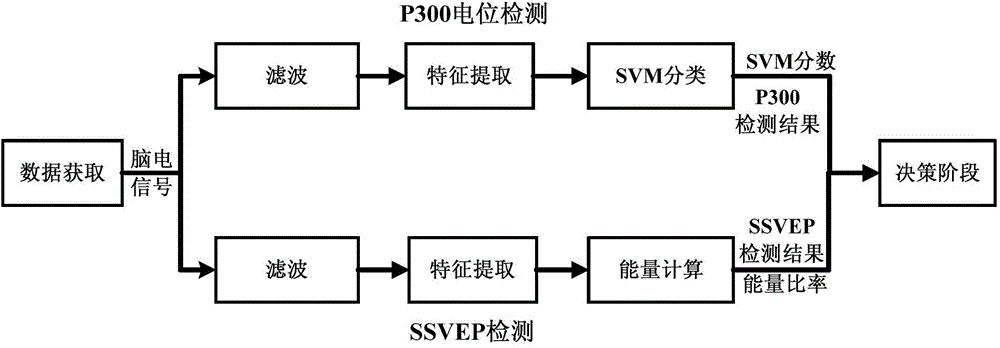Detecting method for multi-modal brain switch based on SSVEP and P300
A detection method, brain switch technology, applied in the direction of mechanical mode conversion, user/computer interaction input/output, computer components, etc., can solve the problem of not having the ability to detect the idle state
- Summary
- Abstract
- Description
- Claims
- Application Information
AI Technical Summary
Problems solved by technology
Method used
Image
Examples
Embodiment Construction
[0066] The abbreviations involved in the method of the present invention are explained as follows:
[0067] Brain computer interface: (brain computer interface, BCI) refers to the direct communication and control channel established between the human brain and computers or other electronic devices, which does not depend on the normal physiological output pathways of the brain (peripheral nervous system and muscle tissue) ), which is a brand-new man-machine interface method.
[0068] Scalp EEG: Electroencephalogram (EEG) is the potential performance of brain activity on the scalp.
[0069] P300 signal: P300 is an endogenous special event-related potential (event related potentials, ERP) related to cognitive function, and its peak value appears about 300ms after the related event occurs.
[0070] Steady-state visual evoked potential SSVEP: Visual evoked potential (VEP) refers to the specific electrical activity generated by the nervous system receiving visual stimuli (such as f...
PUM
 Login to View More
Login to View More Abstract
Description
Claims
Application Information
 Login to View More
Login to View More - Generate Ideas
- Intellectual Property
- Life Sciences
- Materials
- Tech Scout
- Unparalleled Data Quality
- Higher Quality Content
- 60% Fewer Hallucinations
Browse by: Latest US Patents, China's latest patents, Technical Efficacy Thesaurus, Application Domain, Technology Topic, Popular Technical Reports.
© 2025 PatSnap. All rights reserved.Legal|Privacy policy|Modern Slavery Act Transparency Statement|Sitemap|About US| Contact US: help@patsnap.com



